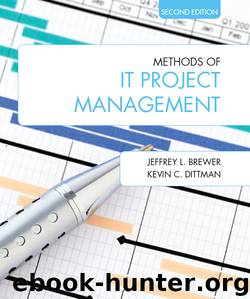Methods of IT Project Management by Jeffrey L. Brewer

Author:Jeffrey L. Brewer
Language: eng
Format: epub
ISBN: 9781557536631
Publisher: Purdue University Press
The cycle consists of five steps:
Step 1. Prepare for assessment—Organizations must understand the contents of the model and the operation of the OPM3. Contents of the standard include the narrative text, the self-assessment tool, and the three directories that contain detailed data on best practices.
Step 2. Perform assessment—The organization’s current maturity state is compared with those described by the model. The first phase of the process looks at which of the best practices the organization is using and plots their use on a continuum of organizational project management maturity. During the second phase, the organization gathers further information at a more detailed level to determine which specific capabilities associated with each best practice the organization currently does and does not demonstrate.
Step 3. Plan for improvements—The results from the previous step are used to form the basis of a plan for improvement. The set of best practices that the organization does and does not do forms the basis of the needs.
Step 4. Implement improvements—Actual organizational and process change takes place over time.
Step 5. Repeat the process—The organization can return to the initial step and perform a reassessment or to step 3 to act on other deficiencies already identified.
The cycle is very similar to the PDSA process described earlier in the chapter. Both are intended to be continuous processes for quality improvement. An organization doesn’t just go through the process once, improve a few metrics, and then stop. An organization must always be striving for continuous improvement, and the OPM3 is one method to assist an organization in improving its strategic initiatives through better-run projects.
PMI attributes the following potential benefits to using the OPM3:
It provides a way to advance an organization’s strategic goals through the application of project management principles and practices.
It provides a comprehensive body of knowledge of best practices in organizational project management.
It highlights the most critical areas of organizational project management that need improvement for each individual organization.
It assists organizations in prioritizing and planning strategies for improvement.
Download
This site does not store any files on its server. We only index and link to content provided by other sites. Please contact the content providers to delete copyright contents if any and email us, we'll remove relevant links or contents immediately.
Hit Refresh by Satya Nadella(8987)
The Compound Effect by Darren Hardy(8722)
Change Your Questions, Change Your Life by Marilee Adams(7551)
Nudge - Improving Decisions about Health, Wealth, and Happiness by Thaler Sunstein(7449)
The Black Swan by Nassim Nicholas Taleb(6935)
Deep Work by Cal Newport(6803)
Daring Greatly by Brene Brown(6359)
Rich Dad Poor Dad by Robert T. Kiyosaki(6306)
Principles: Life and Work by Ray Dalio(6110)
Man-made Catastrophes and Risk Information Concealment by Dmitry Chernov & Didier Sornette(5870)
Playing to Win_ How Strategy Really Works by A.G. Lafley & Roger L. Martin(5727)
Digital Minimalism by Cal Newport;(5576)
Big Magic: Creative Living Beyond Fear by Elizabeth Gilbert(5545)
The Myth of the Strong Leader by Archie Brown(5363)
The Slight Edge by Jeff Olson(5312)
Discipline Equals Freedom by Jocko Willink(5232)
The Motivation Myth by Jeff Haden(5116)
Stone's Rules by Roger Stone(4984)
The Laws of Human Nature by Robert Greene(4918)
